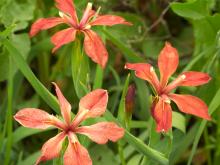Wildflowers, Grasses and Other Nonwoody Plants
Media

Species Types
Scientific Name
Dianthus armeria
Description
Deptford pink has straight, strong, narrow stems that bear small clusters of pink flowers with white dots. Common statewide in sunny, open locations such as pastures and roadsides.
Media

Species Types
Scientific Name
Hemerocallis fulva
Description
Native to Europe and Asia, orange day lily was widely planted by early settlers and has become widely naturalized in North America. The seeds don't mature in Missouri, so all the plants here are spread by root divisions.
Media

Species Types
Scientific Name
Iris domestica (formerly Belamcanda chinensis)
Description
Blackberry lily has leaves like an iris, flowers like an Asian lily, and seeds that look like blackberries! Introduced as an ornamental, this self-seeding member of the iris family occurs on bluffs, roadsides, and old homesites.
Media

Species Types
Scientific Name
Iris fulva
Description
This attractive, copper-colored iris is gaining in popularity as a garden plant even though its numbers are declining in the wild. Like many other native plants, copper iris is hardy, low-maintenance, and has few pest or disease problems.
See Also
About Wildflowers, Grasses and Other Nonwoody Plants in Missouri
A very simple way of thinking about the green world is to divide the vascular plants into two groups: woody and nonwoody (or herbaceous). But this is an artificial division; many plant families include some species that are woody and some that are not. The diversity of nonwoody vascular plants is staggering! Think of all the ferns, grasses, sedges, lilies, peas, sunflowers, nightshades, milkweeds, mustards, mints, and mallows — weeds and wildflowers — and many more!





















